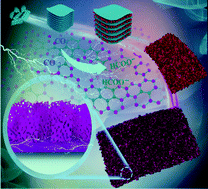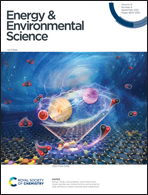Engineering a conductive network of atomically thin bismuthene with rich defects enables CO2 reduction to formate with industry-compatible current densities and stability†
Abstract
The electrochemical CO2 reduction reaction (CO2RR) to value-added and readily collectable liquid products is promising but remains a great challenge due to the lack of efficient and robust electrocatalysts. Herein, a self-supported large-size three-dimensional porous conductive network of bismuthene (Bi-ene-NW) as an efficient superstructured electrocatalytic membrane (ECM) has been pioneeringly assembled, in which the atomically thin Bi-ene with rich edge-site-involved defects is interconnected, highly exposing the active sites. Such ECM can be utilized as an ascendant catalytic cathode, displaying an unprecedented CO2RR performance with near-unity selectivity in a wide potential window and large current density for formate production. Remarkably, when integrated into a gas diffusion electrode (GDE) in a flow cell, Bi-ene-NW was capable of delivering industry-compatible current densities up to 560 mA cm−2 for formate production. Moreover, it was ultrastable to continuously operate for over 500 h at a high current density without significant activity decay. Such outstanding performance should be inseparable from its abundant accessible sites with high intrinsic activity, multiple interconnected channels and superior conductivity for mass/charge transport. The operando ATR-IR and theoretical calculations further deciphered that the rich defects in the roughened plane edges and in-plane pore edges of Bi-ene are conducive to the *OCHO intermediate stabilization.



 Please wait while we load your content...
Please wait while we load your content...